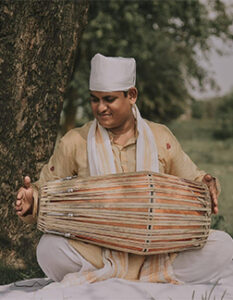
About
Shri Manoj Kumar Das is an Indian musician from Barpeta, Assam. As a Khol player, he has contributed immensely for the propagation of the culture of Sattra . Shri Das has been awarded the Ustad Bismillah Khan Yuva Puraskar -2018 for his contribution to the field of traditional music of Assam.
Date and place of the Interview:
29 August, 2020; Residence of Shri Das, in Barpeta, Assam.
Interview Format:
Face to face conversation
I grew up in an environment of Sattriya culture. My father was a Pathok at the Barpeta Sattra and my two sisters also had active involvement in the cultural field. Academically I started learning Khol in the year 1999, at Shankardev Kalakhetra, which is one of the famous Shankari Cultural Organization in the district of Bapeta established in 1948. My guru was Sattra Bhukhan Shree Jagganath Bayan, who was conferred the Sangeet Natak Akademi Award in 2017. Since last 22 years I have been learning and playing khol.
I started provide training in different parts of Assam when I was in 9 standard. From the year 2012 I started regular training in Shankardev Kalakhetra, Barpeta. At present, I am working for a project on Barpeta Holigeet. Apart from these regular engagements, I perform in both national and international events.
In the year 2013 I started “Academy of Khol Baidyo” at Barpeta. At present more than 200 students, including young girls from different backgrounds are undergoing training. Training is free of cost for the students coming from poor family. Many of my students have been selected for CCRT Young Artist Scholarship.
You have done your homework perfect, it seems -:). We learn playing Khol as per Guru-Shisya custom which has been in place for years. This skill is transmitted from one generation to the next mostly in unwritten ways. Hence, there are not such specific written documents or books of notation of khol rhythm. Whenever I went for training I always felt the importance of a book. Later, I discussed with my guru for publishing a book, that would be more convenient and easy for new learners. This was the genesis of the book “Khol-Baidyo” . Currently, my book is used in the Fine Arts department of several universities.
This is a noble aspiration and it is not possible for me to make it popular alone. To represent khol as an independent and rich instrument we have to compete it with other such instruments that helps to identify in own style. Recently I have started playing “Julagbandi” of khol and other instrument like Tabla. Another way is to deliver lecture on the genesis of Khol, do demonstration and presentation on Khol. In collaboration of Sangeet Natak Academy, I did such programmes in University of Kelaniya in Sri Lanka, Banarash Hindu University and several other leading universities. I am open for invitation for lecture demonstration and presentation on Khol. The initiative such as this (Sattriya Corner) will play a crucial role in taking our indigenous musical instruments to the world stage.
Yes, there are many. In Manipur there is ‘Pung’, in West Bengal they call ‘Shree Khol’, in Odisha there is ‘Mardol’ that is used in Odissi Dance. In our state, we also have ‘Mrindanga’. Outside India, in Shri Lanka there is one instrument named ‘Ghatbere’ which is very similar to Khol. In spite of the similarity, we must remember the rhythms and playing styles are completely different for all the instruments mentioned.
What do you think about the role that Government can play to popularize khol badan across the world?
My only request to our Government to initiate procedures for granting official recognition of Khol in the academia, just like Sattriya Dance. This can’t be a sinle handed approach and I can promise my full support to the government in this endeavour.
I dream of opening an university with independent departments for Music, Instrument and Dance. I am thinking this in the form of Gurukul where students from any parts of the globe would come, stay and learn about our culture. We will start with Diploma course first. The syllabus will be designed keeping international standard in mind. There will be emphasis on Barpeta and Assamese folk culture in my dream university.
In the year 2014, under Intangible Cultural Heritage, I did a research project titled ”Exploration and Documentation of the notation of the Khol Rhythm, traditionally being offered before theater in Barpeta Satra for the last 432 years“. All rhythms are available both in audio and video format. During the Junior Research Fellowship 2017-18 under the Ministry of culture, I undertook a project on “Similarities and Differences of the Khol Rhythm between Barpeta Sattra and Sundaridiya Sattra”. I am in conversation for starting two other academic porjects very soon.
I see huge potential in this space. Khol is an instrument used in many popular music and films. Someone can establish as a music composer. There are several governmental schemes, projects and scholarship that students may avail towards making a career in this domain. Above all, the relationship of Khol with Sattriya Culture is something that can lead to several opportunities inside and outside India.
